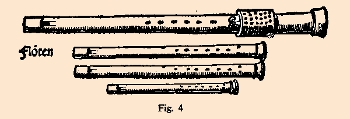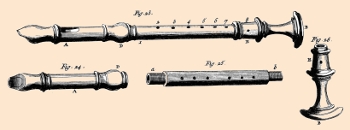PHILIPPE BOLTON
FLUTES A BEC & FLAGEOLETS FAITS A LA MAIN
THE EVOLUTION OF THE RECORDER'S BORE
hape. The diagrams below show some examples of bore profiles from different periods of the instrument's history and can give some idea of how it evolved over the centuries..
THE MEDIEVAL RECORDER
The shape of the bore of the first recorders was probably very simple, just a cylinder of the same diameter from one end to the other. Given correct proportions, an instrument made this way would have had a range of one octave and a sixth or a seventh, with fairly loud low notes, using the first two registers. One disadvantage of this kind of bore might have been the impossibility of making large instruments of reasonably short length with holes small enough and sufficiently close together for comfortable playing.
THE RECORDER DURING THE RENAISSANCE

The first change brought about to the recorder's bore profile was putting in a choke or contraction towards the bottom of the instrument, possibly with the aim of having smaller holes.
| Window end |

The bore profile of the tenor recorder n° SAM 142 in the Kunsthistorishes Museum in Vienna |
Bell end |
The drawing above illustrates the bore of a typical tenor recorder made in the XVIth century. The labium is on the left and the bottom of the instrument
on the right.
The graph shows the changes in diameter all along the instrument. For easier interpretation the diameter scale has been considerably enlarged. The hole positions are indicated underneath ( ).
).
The upper part of the instrument is roughly cylindrical, and starts to contract near the first hole, the narrowest part being near the lowest hole, after which it
expands again towards the end.
A recorder made this way would have been fairly loud, on account of its wide bore, and would normally have had a usable range of one octave and a sixth or a seventh,
like that of the cylindrical instruments. It would have played according to the fingering charts of Virdung and Ganassi (the first table).
To make this choke, the instrument would first have been bored to the smallest diameter, then the inside would have been enlarged from both ends using reamers.
Towards the middle of the XVIth cenury, another type of bore began to appear. This one is shown below and could be called a "step bore". Its main characteristic is a long cylindrical section, followed by a large choke in its lowest part. It enables the use of the third register for the highest notes, giving the recorder a range of two octaves or even more, with perhaps some loss of power for the lowest notes. It can be seen in instruments by Claude Rafi and other makers of the time.
| Window end |

The bore profile of the tenor recorder n° SAM 148 in the Kunsthistorishes Museum in Vienna. |
Bell end |
The fingering chart published by Philibert Jambe de Fer in 1556 was probably for an instrument of this type, of which some may still have been made well into the XVIIth century. Some recorders by Kinseker have the same type of bore.
THE TRANSITIONAL RECORDER OF THE XVIIth CENTURY

The "choke bore" of the renaissance recorders gradually developed into a conical profile. An inverted cone (contracting towards the lower end) emits lower frequencies than a cylinder of the same length. It also enables the use of smaller holes. Instruments could therefore be made shorter and easier to play with virtuosity. The recorder was becoming a solo instrument
| Window end |

The bore of Richard Haka's pre-baroque soprano (descant) recorder in the Edinburgh University Collection of Historical Instruments |
Bell end |
This is a slightly conical bore, giving a range of over two octaves. The fingerings are those given by Mersenne in his chart, and by Blankenburgh
in the text published with van Eyck's Fluyten Lust-Hof. Blankenburgh uses the second register for the highest note of the second octave (high b on an instrument in c) whereas Mersenne uses a third register fingering for the same note.
On the instrument shown above both work correctly, so either of these can be used for top b.
This type of bore has one disadvantage, however. It is not conical enough to enable large instruments to be made in this manner, because they would be too long with holes too far apart.
For comparison, here is the bore of the alto (treble) recorder alto by Kynseker n° MIR 100,in the Germanisches Museum in Nuremberg, made around 1670:
| Window end |
Window end 
This profile, also capable of giving a range of at least two octaves with Mersenne's fingerings, is very similar to that of the instrument n° SAM 148 in Vienna (illustrated above) which might have been made a century earlier. Different types of recorder were probably in use during this transitional period between the renaissance and baroque styles. |
Bell end |
THE BAROQUE RECORDER

An important change took place in recorder making towards the end of the XVIIth century, in order to give it a completely solo character. This improved its ergonomics and extended its range, using the third register (fairly easy fingerings), at the top of the second octave, and the fourth register for notes higher still.
The new design is said to have been brought about by the Hotteterre family in France, but it may have originated in Italy. It became widespread in Europe during the baroque period.
| Window end |

The bore of an alto (treble) recorder by a member of the Hotteterre family (end of the XVIIth century) in the Musée de la Musique, in Paris |
Bell end |
Until the last decades of the XVIIth century recorders had usually been made in one piece (except the very large instruments). From then on they were being made in three parts instead. The main reason for this new technique was the bore profile, which was becoming more and more complicated, and easier to adjust in shorter pieces of wood.
In baroque recorders the bore of the head is usually more or less cylindrical, but could be tapered instead. The bore in the middle and foot joints is more conical than in instruments made previously, Consequently they could be made shorter with smaller and more closely spaced holes.
The typical irregular profile illustrated in these two examples shows a
series of "chambers" or cavities for adjusting the balance of the different registers for both tuning and sound quality. Sometimes there can be "steps" in the bore between the different parts as in the Hotteterre instrument above.
| Window end |

The bore of the alto (treble) recorder by Thomas Stanesby Junior (first half of the XVIIth century) in the Musée de la Musique, in Paris This is a later recorder than the previous one. It was made in London by Thomas Stanesby Junior. There are no steps here, but the tapered bore is more complex than that of the Hotteterre instrument, with a succession of characteristic "chambers" or cavities which are there for intonation, tone quality or speech. Each of these would have been adjusted with a separate reamer |
Bell end |
THE FRENCH FLAGEOLET OF THE XIXth CENTURY

| Window end |

The bore of a flageolet by Prudent Noblet (mid 19th century) |
Bell end |
The flageolet coexisted with the recorder from the renaissance onwards. It did not disappear after the baroque period, but was used during the whole of the ninteenth century, and even later. This is the inner profile of a flageolet made around 1860. The irregular tapered bore is similar to that of a recorder. The French flageolet has four holes in front, and two thumb holes behind (shown below the bore graph in this diagram), of which the upper one is used as a vent hole for high notes as on the recorder. The inside of the conical windcap is not shown in the drawing but can be seen here.
